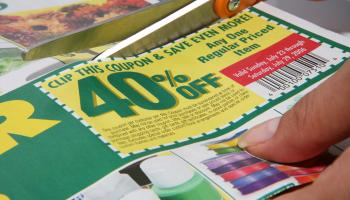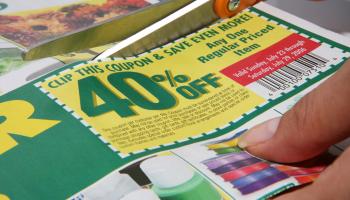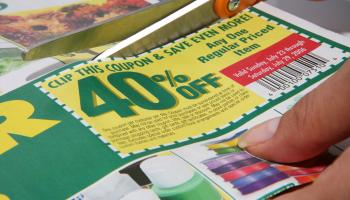 I received a great question from Michelle and thought everyone might like to read my thoughts. Here is her question:
I received a great question from Michelle and thought everyone might like to read my thoughts. Here is her question:
I’ve enjoyed learning about couponing from your site. One of the questions I haven’t seen addressed in my review of your site is: “Why should I coupon if I always buy generic store brands?” This is something I’m very interested in hearing about, since I try to buy generic and also work to limit the convenience foods we buy. Have you already posted about this elsewhere on your site? Thanks!
Michelle
I want to start by saying that there is not one right way to buy groceries. Everyone’s situation is different. We have different amounts of time and talent. Some of us shop with small kids in tow or only have one family car. I love couponing and believe it’s the best way (used in conjunction with lots of other strategies) to lower your food bill. However, when I can’t find something with a coupon (like Parmesan cheese), I don’t hesitate to buy generic. My favorite source for generics is Aldi. You can read my thoughts about Aldi here.
A few weeks ago, I was shopping at Kroger when I saw a young mom pick a dented can of Kroger brand Manwich off the clearance shelf. It was marked down to .49. She was studying it carefully to determine whether or not to buy it. I accosted her (please forgive me if I do this to you in the store, it pains me to see you pay a penny more than you have to), and asked her if she couponed. She was clearly taken aback and told me that she always shopped generics and she felt this was the cheaper option. I told her that Manwich was on sale that week and that with the coupon she could buy it for .20. I apologized for bothering her and scurried away to purchase my 8 cans. I would have shared a coupon with her, but needed all that I had with me to work the Mega deal.
This is a great example of why couponers and generic only shoppers have trouble seeing eye to eye. Generic only shoppers look at the regular price of name brand items, subtract the value of the coupon, and it is clear that the generic is cheaper. They are right. What they don’t understand is that couponers “only use a coupon in conjunction with a sale” (even my 11yr. old can repeat this mantra). So the Publix bread crumbs are $1.69 a container, the Progresso are 2.69, and I have a .35 coupon. Seems like an easy choice. But the Progresso bread crumbs will go on sale B1G1 free and then I will use my coupon. Voila! I pay only .65 for my bread crumbs.
The reason this method of using coupons seems unrealistic to some is that it requires a shift in the way you shop and meal plan. After all what if bread crumbs and Manwich are not on your menu plan for the week. I have already addressed this issue here.
The other item that Michelle hinted at in her post is the common question that drives at the idea of eating less processed foods. I think it is a misconception that you need to eat lots of processed foods in order to save money with coupons. As an example, I’m going to pull some items off of this weeks Publix list that could fit into a diet of home cooking and minimal processing:
Buy One Get One
Progresso 100% Natural Broth, save up to $2.59
-.50/1 any Progresso broth printable
-$1.25 off any Progresso broth printable (IE) or printable (FF)
Juicy Juice 100% Premium Juice, 64 oz bottle, save up to $3.49
-$1/2 off any Juicy Juice Products SS 1/04, 2/01 or printable (makes it $1.24 ea)
Progresso Bread Crumbs, 15 oz canister, save up to $1.93
-$1/2 any Progresso product except soups printable (makes it .46¢ ea)
Crisco 100% Extra Virgin Olive Oil, 16.9 oz bottle, save up to $6.49
-$1 off any Crisco Olive Oil RP 2/08 (makes it $2.25 ea)
Kashi Instant Oatmeal, 11.28 or 12.1 oz box, save up to $3.59
-$1 off Kashi Hot Cereal or Oatmeal Mambo Sprouts Booklet (makes it .80¢ ea)
Earth’s Best Organic Baby Food, 6 months and up, 4 oz jar, save up to $1.09
-$1/8 Earth’s Best Foods Mambo Sprouts Booklet
-$1/10 Earth’s Best Foods printable
-$1/6 Earth’s Best printable (Food Lion)
(use FL printable with manufacturer makes it .29-.34¢ ea)
Green Giant Boxed Vegetables $1 ea
-.50/2 or $1/2 GG Boxed Veges SS 01/04 (makes it .50¢ ea)
-.60/2 GG Boxed Veges printable
**Qualifies for Publix Rebate in SS 2/08, buy 15 items get $10 back- buy 15 make $2.50 after rebate**
Other
Progresso Tomatoes $1.25 ea
-$1/2 any Progresso product except soups printable
Sargento Shredded Cheese $2 ea
-$1/2 Sargento Shredded Cheese SS 1/25 (makes it $1.50 ea – stock up price)
It may take more time to build up your stockpile if you have a lot of perameters on what you will purchase and what you will not. But clearly, it’s possible to save money and eat a healthy, less processed diet and coupon at the same time. In addition, saving money on toiletries and cleaning supplies may free up money in your budget for more expensive items.
I hope this answers Michelle’s question, as I know it’s one that lots of people are wondering about. Please contact me at frankmomof3@yahoo.com. I may not be able to answer you right away, but I will tuck your question away and try to address it in a later post.




